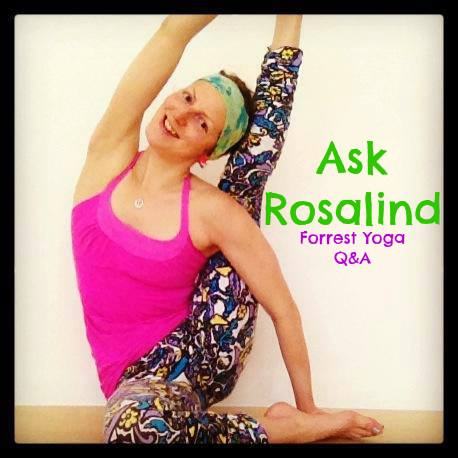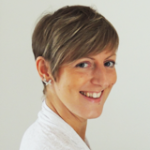Rosalind Southward on Cambridge Forrest Yoga
Rosalind Southward on Forrest Yoga
 Q1. What makes Forrest yoga different from all the other schools & styles of yoga?
Q1. What makes Forrest yoga different from all the other schools & styles of yoga?
ROSALIND: For me Forrest Yoga is different to other schools/styles of yoga for its emphasis on using yoga as a way to heal yourself physically, emotionally and psychologically; it empowers you by giving you the tools you need to be able to do this powerful work for yourself. Ana developed the practice through working with her own injuries and traumas so it’s a system which is derived from her personal experiences and discoveries – for me this makes it more real and relevant. Forrest yoga takes traditional yoga poses and adapts them so they give our tweaky modern day stressed out bodies and minds what they need. As a student you are taught how to work the poses for your body; alignment is important, but we’re all in different bodies and working with different limitations so being taught to work in this way is a really valuable experience. Hands on assists are a big part of a Forrest class and as teachers we are taught how to work with students to help them to heal; so an adjust is not about getting deeper into the pose but to help you get what you need out of it. I think the emphasis on breath is really significant in Forrest yoga too – as some of you have already heard me say, although I thought I knew how to breathe deeply I discovered I really wasn’t breathing at all until I trained with Ana! Finally, one more very special element to Forrest yoga is the way it incorporates ceremony from the Native American Indian tradition and more shamanic practices. This really resonates with me and was one of the reasons I was drawn to this style.
Q2. What drew you to Forrest yoga?
ROSALIND: It’s funny – I feel like I didn’t really choose Forrest yoga, it chose me. The first Forrest class I took I was on holiday in Bali; I had problems with over-exercising so I was trying to do as many classes as I could each day. I found myself in a Forrest class with no idea what to expect and wondering if the person who wrote the schedule had made a typo. The thing that struck me though was using the breath to heal your body; literally breathing and sending the breath energy to wherever you need it – this really fascinated me. When I decided to do my first teacher training I actually applied to do a vinyasa course in India; but they wouldn’t accept my application because I told them about my herniated disc in my low back. I was told I wouldn’t be physically able to do it, which really upset me. A few weeks later I found an advert for a training being run by the teacher I had taken Forrest classes with Bali and I knew then that this was the course I was destined to take. Although this first training wasn’t a Forrest training, our morning practice was taught using Forrest sequencing and after 4 weeks of this, the differences I felt in my body were amazing. After this training I started a personal Forrest based practice, took workshops with Ana, bought her DVD’s – I couldn’t get enough! When I started teaching, I realised that I was essentially teaching what I practised – Forrest yoga and that I really wanted to train with Ana to become a certified Forrest teacher. Ironically, I came all the way back to the UK from Malaysia to Peterborough to do the Forrest Yoga Foundation training! The training was an amazing experience, especially with the emotional and psychological process work we did. For me this is a very powerful method of yoga – it heals injuries, builds strength in the body and enables you to connect with yourself authentically. I really honestly believe in it as system and it’s for this reason that I want to take it out and share this with others.
Q3. I've seen pictures of you in some amazing advanced postures. Do you think that advanced posture practice is important to yoga and something to aim for?
ROSALIND: Advanced poses are fun to master if that’s where you’re at, but no I definitely don’t think that they are the be all and end all of a yoga practice. If you become hell bent on achieving certain poses it’s almost like you end up in competition with yourself, and you get attached to the pose – this isn’t yoga. I know this sounds like a cliché and I’m sure you’ve heard it before, but it really isn’t about the end goal or destination but what you learn on the way there. When you’re learning a new pose (or any new skill for that matter) there’s this really long period of time where you are on the plateau – the time when you feel that you’re not improving or getting anywhere. But this is the part we need to learn to love, and when we focus on this and not what we’re aiming for, ironically that is normally when the improvement happens. I spend a lot of time on my mat, and whilst I can do some “advanced poses” that have been captured on film, I also spend a lot of time falling out and not looking quite so amazing. (There have been some classic bloopers too believe me!) With my handstands, I realised I had to stop focusing on getting both legs straight up and step back a stage and figure out where exactly these muscles are that are actually going to hold me up. I got it for about a week, and just when I got complacent I lost it again. So, I’m back to reconnecting and figuring out what else there is to discover that I haven’t noticed so far. But this is what keeps me so fascinated I guess!
Q4. Can you describe your daily practice?
ROSALIND: I practice pretty much every day, mostly in the mornings right after I get up. My main practice is a Forrest based practice – it makes such a difference to my tweaky low back and helps me to figure out whatever things might be playing on my mind or that I am processing at that time. I always start with pranayama – I find this helps me to wake up first thing in the morning, way better than a cup of coffee does. Then I move into seated poses, followed by lots of core strengthening work, and a bridge pose or variation. Next comes dolphin pose, and maybe some inversion work depending on how warmed up I’m feeling – I make sure I work on my handstands/and or forearm balance every day so I can keep working on what I’m learning in these poses. Then I do lots of sun salutations to get really hot, and this is normally when the music comes on if it hasn’t already! I don’t teach Forrest yoga to music but I enjoy having it in my personal practice. And I’m sure you’d smile if you could see my playlists – lots of hip-hop, R’n’B and funky beats and I do sometimes break into a dance in the middle of my practice too! Once I’m nice and hot I work with standing poses and maybe arm balances or back bends depending on what type of sequence I’m doing. My personal practice is not necessarily what I’m going to teach in class later that day – what I need might not be what my students need. But, at the same time what I learn in my personal practice definitely makes its way into my classes – figuring out how to switch on new muscles, noticing when my breathing goes – there’s always something new to learn and that’s what I love about yoga.
Q5. What is the best piece of advice you've ever been given?
ROSALIND: To stop struggling to be perfect or how you think everyone else wants you to be. I spent too many years trying to shoehorn myself into the image that I thought everyone expected from me; it made me desperately unhappy, sick and trapped in a cycle of bad habits. The relief of just being myself was immense, and my yoga practice changed too as a result. Or maybe it was that I changed my attitude to my yoga practice and it naturally evolved from there. I’m thankful that Ana opened my eyes to the fact that it’s ok to be my authentic self and to speak from a place of real truth even when it feels difficult and scary to do so. And when you don’t feel like you have the courage, to take a deep breath and then speak from there.
 Rosalind is an Advanced Certified Forrest Yoga instructor and teaches Forrest, Yin Yoga and Yoga Flow at Camyoga, Cambridge. To book onto one of her classes click here.
Rosalind is an Advanced Certified Forrest Yoga instructor and teaches Forrest, Yin Yoga and Yoga Flow at Camyoga, Cambridge. To book onto one of her classes click here.
